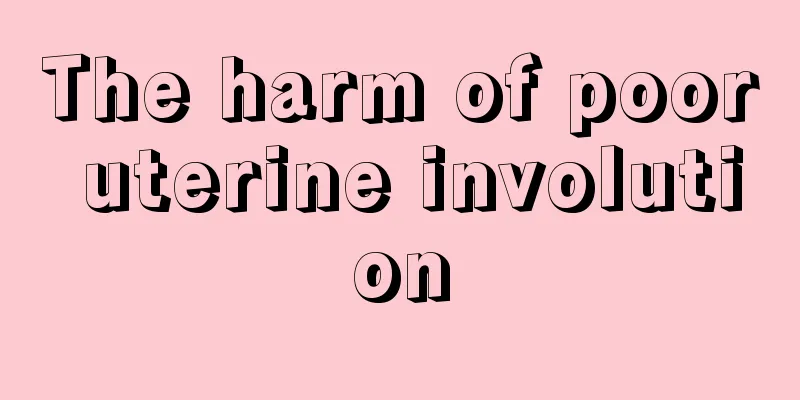The harm of poor uterine involution

|
If a woman does not pay attention to medical care and maintenance of her body after giving birth, or if she has an infection after giving birth, it will affect the body's recovery, especially the recovery of the uterus. In daily life, many women encounter hidden dangers of uterine repair after giving birth. So, what are the harms of poor uterine repair? What are the symptoms of this situation? How to deal with it? Let us learn about it together below. Poor uterine repair after childbirth means that within 6 weeks after childbirth, the uterus has not recovered to its (non-pregnant) size. What are the harms? Let's analyze it. From a time perspective, there may be the following impacts: 1. Short-term impact: a. Increased bleeding during the confinement period leads to anemia, dizziness and other discomforts, which affects the whole body recovery of pregnant women; b. Poor uterine repair is mostly related to postpartum infection (equivalent to pelvic inflammatory disease), which not only causes postpartum lochia odor, but also causes fever and other discomfort if neglected; c. For patients who underwent cesarean section, poor uterine repair will affect uterine contractions, which may affect the healing of uterine wounds and the formation of uterine diverticulum. 2. Medium and long-term impact: a. Poor uterine repair and incomplete anti-infection treatment related to puerperal infection will lead to chronic pelvic inflammatory disease for a long time, affecting future pregnancy and other problems; b. For women with poor uterine repair, the uterine volume expands when not pregnant, and the total area of the uterine wall is relatively expanded, which leads to an increase in menstrual flow; c. The increase in uterine volume and weight will increase the pressure on the pelvic support tissue, increasing the probability of uterine prolapse in the future. d. The poor short-term effects after childbirth increase the probability of postpartum depression in pregnant women, which affects the secretion of milk and even the healthy growth of newborn babies. Symptoms of poor uterine repair after childbirth: 1. The duration of postpartum lochia is prolonged. When the uterus is not well restored after childbirth, vaginal bleeding may last longer, exceeding seven days or more than ten days or even longer, and sometimes even for a month. 2. Non-menstrual bleeding or heavy bleeding. Long-term non-menstrual bleeding or turbid lochia, or odorous, purulent discharge during infection may be caused by poor uterine repair. 3. Pelvic and low back pain. When the uterus is not repaired well, pelvic pain or a feeling of pressure may occur. The waist and abdomen may feel painful and falling. Some people may also experience back pain or abnormal fatigue. 4. There are abnormalities in the uterus, such as the uterus being enlarged and soft, or there being a sense of tenderness when lightly pressed. What should you do when your uterus is not repaired well? You can repair it by massaging the uterus, or use Chinese and Western medicine uterine contraction agents for treatment, or take Shenghua Tang for treatment. Of course, the most important thing is to choose the right method for symptomatic treatment to help the uterus recover faster. Any residue may cause infection, so cephalexin and ornidazole can be taken orally for treatment, followed by a repeated curettage to prevent the infection from spreading. After the operation, uterotonics should be given to promote uterine contractions, and broad-spectrum antibiotics should be used to promote uterine contraction. The above are some symptoms of poor uterine repair after childbirth. When a woman who has given birth has some of the above symptoms, she needs to consider the possibility of poor uterine repair and seek medical attention in time to confirm the diagnosis and deal with it properly. For cases of incomplete uterine repair, effective treatment methods can be taken according to the specific situation to promote uterine contractions. |
<<: How long after hysterectomy can I go out
>>: What is the use of washing the vulva with soda water?
Recommend
Zhou Haimei's cause of death announced! Beware of the signs of a heart "strike", especially for those living alone!
Recently, Zhou Feng, the sister of the famous act...
The leading cause of death among Chinese people is actually this! You need a "healthy diet model" that is more suitable for Chinese people
Recently, the "Guidelines for Blood Lipid Ma...
Latest implantation time of gestational sac
When is the latest time for the gestational sac t...
What is the reason for bleeding after having sex after menstruation?
Menstruation is a normal metabolic activity of th...
How to grow the placenta if it is too low
Pregnant women may experience low placenta during...
Is acute mastitis during breastfeeding dangerous?
Female friends suffer from mastitis during lactat...
I fell and lost my baby at 38 weeks of pregnancy
Many pregnant women worry about placental abrupti...
Don't eat it! Don't eat it!
Cold and dry winter Sweet and juicy sugar cane Es...
Apple's retail store operating secrets to maintain sales
There was an article about Apple retail stores th...
What are the dietary taboos for pelvic inflammatory disease
Pelvic inflammatory disease can be cured through ...
Breast fibroids 4a
Breast disease is a common disease among women no...
"Seventh to eight but not alive"? Premature babies are more likely to have these dangerous conditions, and care should pay attention to 4 points
gossip November 17 (tomorrow) is World Prematurit...
Will there be more vaginal discharge before menstruation?
Before a woman's menstruation comes, there wi...
Female urethral pain urination pain
Some girls always feel pain in their urethra, but...
How to tighten the vagina after childbirth
We all know that before giving birth, the uterus ...









